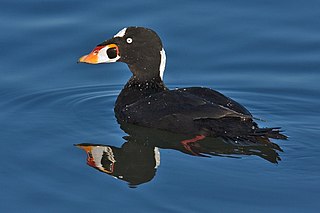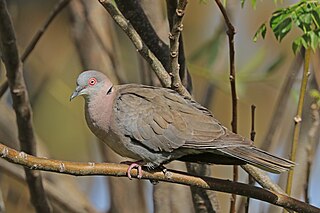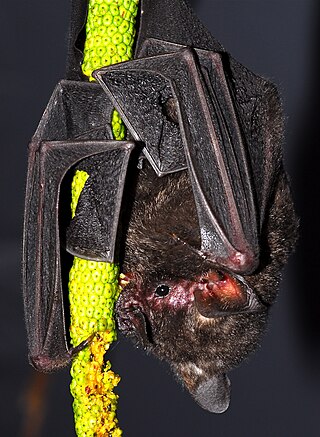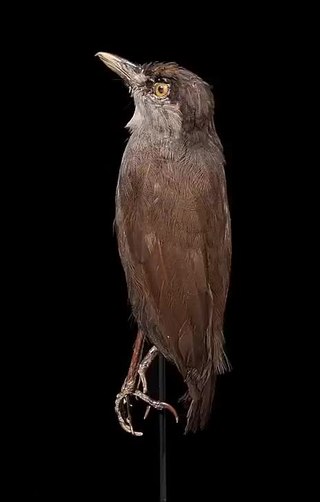
The surf scoter is a large sea duck native to North America. Adult males are almost entirely black with characteristic white patches on the forehead and the nape and adult females are slightly smaller and browner. Surf scoters breed in Northern Canada and Alaska and winter along the Pacific and Atlantic coasts of North America. Those diving ducks mainly feed on benthic invertebrates, mussels representing an important part of their diet.

The mourning collared dove or African mourning dove is a dove which is a widespread resident breeding bird in Africa south of the Sahara. Despite its name, it is not related to the North American mourning dove. This species is common or abundant near water. They often mingle peacefully with other doves.

The Asian small-clawed otter, also known as the oriental small-clawed otter and the small-clawed otter, is an otter species native to South and Southeast Asia. It has short claws that do not extend beyond the pads of its webbed digits. With a total body length of 730 to 960 mm, and a maximum weight of 5 kg (11 lb), it is the smallest otter species in the world.

The spectacled owl is a large tropical owl native to the neotropics. It is a resident breeder in forests from southern Mexico and Trinidad, through Central America, south to southern Brazil, Paraguay, and northwestern Argentina. There are six subspecies. One is occasionally treated as a separate species called the short-browed or brown-spectacled owl but the consensus is that it is still merely a race until more detailed analysis can be done.

The chestnut short-tailed bat is a bat species from South and Central America. The species is often confused with the Benkeith's short-tailed bat. It is a mainly frugivorous species that has been known to consume insects. To determine which pipers to forage on, it focuses on odour and then after proceeds to echolocate to determine position. It hunts between nightfall and midnight. Habitats include hollow trees, caves, cracks, abandoned mines, sewers, and house roofs. It does not decrease activity during full moons, only instances of turbulent weather like heavy rain. In an agricultural setting it has a higher resistance to habitat fragmentation compared to similar bat species.

Seba's short-tailed bat is a common and widespread bat species in the family Phyllostomidae. They are found in Central America, the northern parts of South America, and in the Antilles islands.

Carollia is a genus of bats often referred to as the short-tailed fruit bats. Along with the genus Rhinophylla, Carollia makes up the subfamily Carolliinae of family Phyllostomidae, the leaf-nosed bats. Currently, nine species of Carollia are recognized, with a number having been described since 2002. Members of this genus are found throughout tropical regions of Central and South America but do not occur on Caribbean islands other than Trinidad and Tobago. Bats of the genus Carollia often are among the most abundant mammals in neotropical ecosystems and play important roles as seed dispersers, particularly of pioneer plants such as those of the genera Piper, Cecropia, Solanum, and Vismia. Carollia are primarily frugivorous; however, C. perspicillata, C. castanea, and C. subrufa are known to feed on insects.

Lutrogale was proposed as generic name by John Edward Gray in 1865 for otters with a convex forehead and nose, using the smooth-coated otter L. perspicillata as type species.

The smooth-coated otter is an otter species occurring in most of the Indian subcontinent and Southeast Asia, with a disjunct population in Iraq. It is listed as Vulnerable on the IUCN Red List since 1996 and is threatened by habitat loss, pollution of wetlands and poaching for the illegal wildlife trade. As its name indicates, its fur is smooth and shorter than that of other otter species.

The spectacled salamander is a species of salamander in the family Salamandridae.

Salamandrina, the spectacled salamanders, is a genus of salamander, the only of subfamily Salamandrininae in the family Salamandridae which is still alive, as one of its own relatives is extinct. The IUCN Red List follows Mattoccia et al. (2005) and Canestrelli et al. (2006) in accepting two species, both only found in Italy:

The spectacled imperial pigeon is a species of bird in the family Columbidae. It is endemic to the Maluku Islands.

The black-browed babbler is a songbird species in the family Pellorneidae. The species is endemic to Borneo. Only a single specimen collected in the nineteenth century was known, until the species was rediscovered in Borneo in 2020.

The Moroccan rock lizard is a species of lizard in the family Lacertidae. Its classification is uncertain and it has been placed in the genera Teira, Podarcis, Lacerta or Scelarcis. It is found in Algeria and Morocco and has been introduced to the island of Menorca in Spain. Its natural habitats are Mediterranean-type shrubby vegetation, rocky areas, sea coasts and urban areas.

Carolliinae is a subfamily of bats.

Salamandrina perspicillata, the northern spectacled salamander, is a species of salamander in the family Salamandridae found only in Italy.
Cyrtarachne perspicillata is a species of spider of the family Araneidae. It is found in Sri Lanka, Sumatra, Java, and New Guinea. The subspecies Cyrtarachne perspicillata possoicaMerian, 1911 is found in Sulawesi.

Oberea perspicillata, the raspberry cane borer, is a species of flat-faced longhorn in the beetle family Cerambycidae. It is found in North America.

Ommatolampis is a genus of short-horned grasshoppers in the family Acrididae. There are at least four described species in Ommatolampis, found in South America.
The Beas Conservation Reserve covers an 185 km stretch of the river Beas. The area of the Reserve lies primarily in north-west Punjab. It was declared a conservation reserve by the government of Punjab, India in 2017. The Beas flows down meandering from the Himalayan foothills to Harike Headworks, where it spreads into multiple channels. The braided channels form islands and sand bars creating a complex environment that supports rich biodiversity. In September 2019, the reserve was declared a Ramsar site under the aegis of the 1971 Ramsar Convention on Wetlands of International Importance.

















